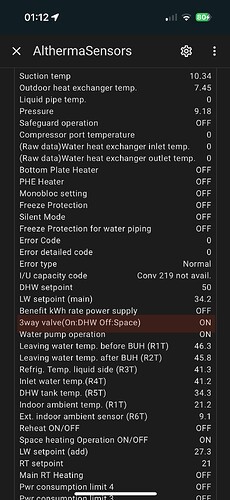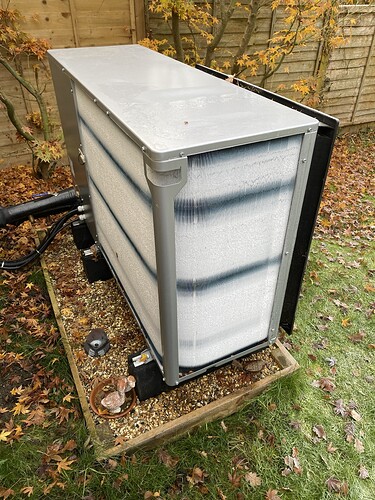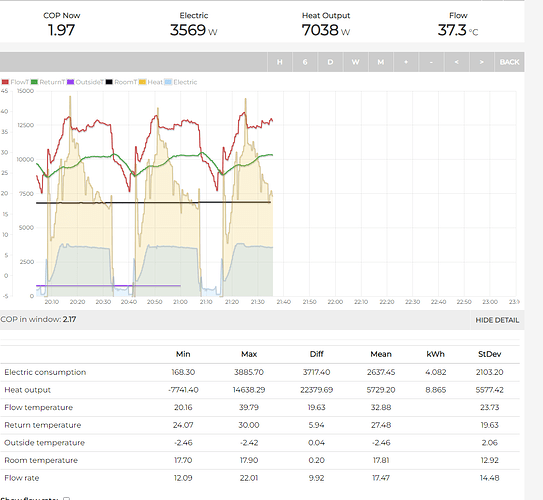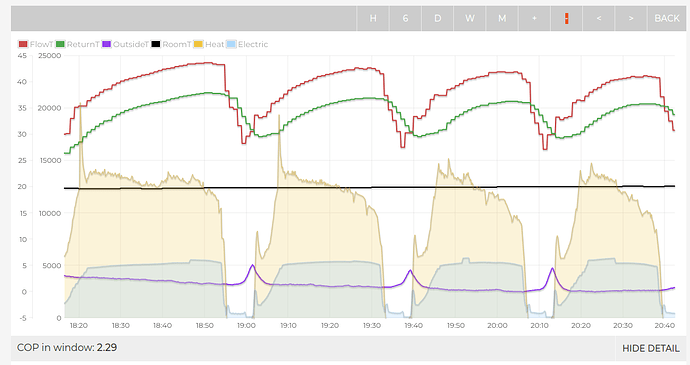Yup. Took me a while to get it going, but should be working now.
The only thing I’m struggling with now and can’t figure out is the 3way valve flag in home assistant so I can send across to Emoncms the DHW “flag”.
Weirdly this is off most of the time, yet on for DHW, so I’m getting the data, just can’t work out how to get it as a binary 0/1 which I can then get to Emoncms.
Have you got this working?
Hopefully yes, but I have yet to install the latest config which includes it in the code.
However, I set the #define that sends each value as a separate MQTT message, and changed the topic (emon/ASHP/) so that EmonCMS would pick them up directly, rather than via HA.
I have used a NodeRed flow to check the value and send appropriate Space Heating and DHW 0/1 MQTT signals, which works on test and hopefully will work once code installed on ESPAltherma.
I reckon you could use the incoming MQTT message to HA to generate outgoing MQTT messages directly to EmonCMS, but I’m not sure how you’d do it. EDIT: Check HA MQTT Notifications - they involve Automations, Scripts and templates, which is more than I want to know about HA, but maybe it’s cool for you.
The alternative is just to write a Python script (other tools are available!) to republish MQTT messages on receipt of the big JSON message.
My 9kW seems to gather frost in the same pattern as @matt-drummer, I have never seen it fully frosted up
Mine has been completely iced up today.
I don’t understand what is going on with my heat pump.
I have the flow set at 42c but it never gets there, the temperature builds at first and then drops away.
My system was designed to run at 50c flow at -2.3c outside.
I have increased my radiator sizes considerably to allow the heat pump to run at lower flow temperatures when it is warmer outside as the heat pump is too big for our house and the radiators were too small for its minimum output.
Are my radiators now too big as it is cold?
If I were to run at 50c flow wouldn’t I, in theory, produce more heat from the radiators than the heat pump can deliver?
Are my radiators now limiting my flow temperature?
From my limited understanding of radiators, I don’t think it’s possible to have too much emitter surface.
Chart shows steady electrical input (maximum?) and heat output that peaks after 10 minutes, then gradually tails off due to ice until the defrost 20 minutes later. Performance (and therefore heat output) is limited by ice on the coils. So, the heat pump is unable to reach 42 degrees.
While smaller radiators might result in higher flow temperature, it would not be more heat energy, possibly even less.
Thanks Tim,
That is kind of what I thought.
But with my now massive radiators flowing 42c and a return of 33c I am going to be putting out more than the heat pump can manage?
It is funny that I initially get to 40c and then the flow temperature drops?
If the system was designed to run at 50c flow when it is -2.3c outside I struggle to see how it was ever going to mange it? I wonder how Octopus thought this would work?
My maximum heat output at -3c seems to be about 6kW allowing for the defrosts, 25 minutes of heating and then 10 minutes defrosting, it’s actually producing heat for about two thirds of the time.
It all seems a bit rubbish, I have a maximum output of 6 to 6.5kW at -2c and and a minimum output of around 4.6kW at 7c if I want to run at the best efficiency.
Not much of a range of operation?!
I have just changed it back to fan coils as originally set by the installers, I have been running as radiators for most of the time with a fixed delta t of 8c. I want to see how it performs with fan coils set now my radiators are bigger.
Big radiators will reduce the flow temperature, shedding heat from the heat pump faster than small radiators. I don’t think that can adversely affect the heat pump itself.
Cos of the backup heaters?
My own Mitsubishi has been defrosting regularly all day today.
Hi Tim,
I never thought the big radiators will hurt the heat pump.
I do think that the the big radiators will constrain the flow temperature because once the maximum heat output is reached the flow temperature cannot increase. The maximum heat is being delivered and any increase in flow temperature would cause more heat production which is not possible.
I see the defrosts everywhere.
That being the case I don’t think it is possible to get to 50c flow with this heat pump and this weather so it must rely on the BUH.
That isn’t a heat pump, it’s just a direct 1:1 water heater
I thought my big heat pump would come into its own on days like these, it seems not.
My heat pump was off for about nine hours whilst we changed the last of my radiators.
It’s ok in the house but the heat pump is struggling a bit, it is not comfortable and doesn’t feel oversized today when I needed to get the house back up to temperature.
Octopus may as well have given us all the 16kW version, I don’t see the point of the other three in the range.
I’m have the model up (11kW nominal), and electrical input peaks I noted last winter and this winter is 5.6kW (!) (no backup heater or booster heater to be clear as they are disabled in settings and switched off physically at the dedicated breaker)
I would have thought the 9kW would be 4.5-5kW peak input just off the top of my head.
@matt-drummer I suspect you may have been able to get to 50C - however as @Timbones has noted, you have now added (in a good and positive way) way more inertia (more water volume/mass, and likely radiators able to dissipate heat more quickly) for the heat pump to overcome.
If it was colder and less humid (so defrost wouldn’t occur), I suspect given enough time it could quite likely reach it.
I note also, you have set quite a high ΔT(7+?) compared to my setup (ΔT5) and this ironically will be doing two things:
-
A higher flow temperature is easier
-
Efficiency could be being lost as the vapour compression cycle (a separate system to the water system) appears to be commonly understood to want to settle down to a ΔTof 5 - this brings flow temp down, but keeps Mean Water Temperature (MWT) the same.
Flow temperature by itself doesn’t tell the whole story. MWT is the thing to concentrate on which means also pay attention to return temps.
@matt-drummer As @marko has mentioned and others such as Heat Geek have noted, in this weather (ironically the wet humid and around freezing) it is intended that the unit run continuously with no breaks. This is literally to avoid oversizing (any further than can be helped).
Having 9 hours of the unit off in this weather, you would expect it to take a while to get back up to design internal temperature.
Again, if it were much colder and dry air, the defrosts wouldn’t:
a) draw heat back outside
b) stop heating for ~10minutes at up to twice an hour (for me yesterday anyway)
Buts that’s the joy of our U.K. climate!
Hi Stephen,
Yes, that is why I changed to fan coils last night as opposed to radiators.
Radiators have a fixed delta t of 8c, the manual says that fan coils have a variable delta t.
Until now I have not had so many options as the original radiators were limiting how low I could go on flow temperature and achieve a reasonable efficiency.
No I have about 40kW of radiator output at a delta t of 50c.
I should be able to go as low as I like within reason.
How do I make the delta t 5c, is there somewhere to adjust it?
What about running as UFH?
I also need to balance these radiators and haven’t had a chance to do that yet.
Given what I think I know/understand about this range of heat pumps I am struggling to see the point of the smaller ones, they have the same low end performance and now I need a BUH to get to meet the design specifications?
Based on our experience with @ColinS’s max output tests we might expect the output to be ~30% below rated capacity in these conditions so ~6.3 kW on yours with a similar COP to what you are seeing, Cooling had a COP of 2.13 for the 7.6 kW max output cycle (11 kW model) in his test too.
That said if the compressor is the same and the evaporator heat exchanger size similar then perhaps the 9kW model should do a bit better as a %… the fan speed is definitely less on the datasheet.
The shape of the flow temperature on your example there looks like it’s being constrained by target temperature. If the target temperature is set high enough, you should see a nice steady curve as the flow temperature increases as far as it can go (which will depend on the balance between the heat pump max output and the radiators system that you have - not the ultimate target flow temp, though these needs to be set high enough to not constrain the maximum).
Steady increasing curve from Colin’s Daikin
What were your target flow temperature settings during that period?
I can’t disagree with this tbh! I guess Daikin price it higher “because”.
What was weird when I found Octopus put in the 11kW when the 9kW was in the paperwork, the 9kW was more expensive than the 11kW but quite a margin.
Makes me wonder if this is the reason, and behind the scenes, Octopus engineers have tested these all out, understood the minimal differences, and actually deliver based on unit cost to them (because they’re all the same apart from max output)
Hi Stephen,
I was horrified when one installer wanted to fit the 14kW here.
I think he may have actually known what he was doing, hindsight is a wonderful thing!
If I were to do this again and had to have one of these heat pumps I would just go straight for the 16kW, I cant see any good reason not to.
I am not sure that Octopus have really thought about this too hard and I truly think they have looked at the range as i did.
I am an accountant and I often find myself working out what things cost whether it was something like this or say in a restaurant.
They had four men working here for a week, one was in a hotel for five nights, there is the survey, the design team and the after care visits.
All of the stuff that arrived, it costs a fortune, I cannot see that they made a penny out of my install.
I’ve just looked logged in as installer user profile (5678) and mine is set to “Fancoil Unit”
Daikin controller —> Main Zone —> Emmiter Type —> Fancoil unit
Under this same menu level there is “Delta T Heating”, and mine is set to 5C
I note from my data I can see it is only really when it settles down it tries to maintain that.
Post defrost, cycling, from cold, or pre-defrost, it adjusts the pump speed quite a bit, sometimes maintaining quite a low ΔT, and then sometimes quite large ΔT
Thanks Stephen.
I will have a play later and during the coming days to see what I can now do with my over radiatored house!
They do look good though, much more in keeping with what you would expect to see in a heat pump house.
It is really quite remarkable how much heat comes off a massive k3 radiator when it is just luke warm.
I have been offered to swap for the 8kW, my gut feeling was that it would be a mistake and now I am absolutely sure it would be.
I am more inclined to ask for a bigger one!
No problem @matt-drummer
You’ve got nothing to lose, you can always set the ΔT back to 7-8 if you don’t get on with it.
One thing to track and make note of is flow rates:
You should see them increase (to keep a smaller ΔT), but your pipework (without knowing or seeing/calculating it) may have issues if:
-
Pump not powerful enough to overcome resistance to flow
-
Additional noise from primary pipework and/or radiator valves at full throttle (our main house radiator primary pipework was left at 22mm by Octopus and at full throttle with dT 5 is audible, so clearly should be 28mm (or increase dT to slow flow rate) and is a future project here to replace. UFH for extension is on separate 22mm primary pipework and unaffected)
I wouldn’t let those put you off testing, just something to be aware of, as you may not see either.



